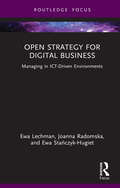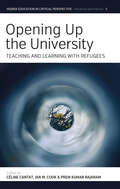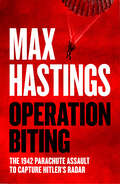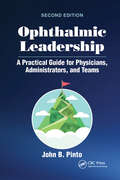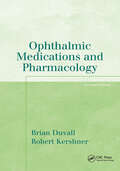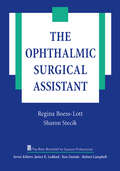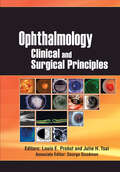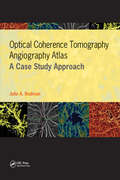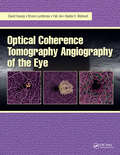- Table View
- List View
Open Strategy for Digital Business: Managing in ICT-Driven Environments (ISSN)
by Ewa Lechman Ewa Stańczyk-Hugiet Joanna RadomskaThis book offers the reader a novel perspective on how digital contexts and open strategy approaches – the act of opening up strategic initiatives beyond company managers to involve front-line employees, stakeholders, and entrepreneurs – are related.Going beyond the claim that digital media drives open strategy by containing a detailed analyses of the interrelations between the two, the authors examine how ICT have diffused globally and trace the emerging links between digitally driven environments and open strategizing approaches. This book also draws a general picture of how and why digital technologies create new networks. A more competitive, transparent, empowered, and inclusive environment would enhance development and encourage novel approaches to strategies implemented. Real-life exemplifications of how and why digital technologies contribute to open strategizing are also provided. Various drivers impacting the necessity to develop more relational advantage are discussed and intertwined with the description of challenges observed in the case of imposing openness.A useful resource for researchers of strategic management and information systems, as well as those looking at digital strategy and transformation.
Open Strategy for Digital Business: Managing in ICT-Driven Environments (ISSN)
by Ewa Lechman Ewa Stańczyk-Hugiet Joanna RadomskaThis book offers the reader a novel perspective on how digital contexts and open strategy approaches – the act of opening up strategic initiatives beyond company managers to involve front-line employees, stakeholders, and entrepreneurs – are related.Going beyond the claim that digital media drives open strategy by containing a detailed analyses of the interrelations between the two, the authors examine how ICT have diffused globally and trace the emerging links between digitally driven environments and open strategizing approaches. This book also draws a general picture of how and why digital technologies create new networks. A more competitive, transparent, empowered, and inclusive environment would enhance development and encourage novel approaches to strategies implemented. Real-life exemplifications of how and why digital technologies contribute to open strategizing are also provided. Various drivers impacting the necessity to develop more relational advantage are discussed and intertwined with the description of challenges observed in the case of imposing openness.A useful resource for researchers of strategic management and information systems, as well as those looking at digital strategy and transformation.
Open Throat: 'An instant classic' - The Guardian
by Henry HokeShortlisted for the James Tait Black Prize for Fiction'An instant classic' - The GuardianI’ve never eaten a person but today I might . . .A queer and dangerously hungry mountain lion lives in the drought-devastated land under the Hollywood sign, overlooking the city that humans call ‘ellay’.Lonely and fascinated by humanity’s foibles, the lion spends their days grappling with the complexities of their own identity, and ultimately the question: Do they want to eat a person, or become one?'A bloody masterpiece.' - Melissa Broder, author of The Pisces'Witty, emotional and gripping, Open Throat is a short but savage thrill ride' - The Independent'Open Throat is Bret Easton Ellis meets mountain lion in the Hollywood Hills . . . it already has people talking' - The Sunday Times
Opening Up the University: Teaching and Learning with Refugees (Higher Education in Critical Perspective: Practices and Policies #5)
by Prem Kumar Rajaram Céline Cantat Ian M. CookThrough a series of empirically and theoretically informed reflections, Opening Up the University offers insights into the process of setting up and running programs that cater to displaced students. Including contributions from educators, administrators, practitioners, and students, this expansive collected volume aims to inspire and question those who are considering creating their own interventions, speaking to policy makers and university administrators on specific points relating to the access and success of refugees in higher education, and suggests concrete avenues for further action within existing academic structures.
Openness and Coordination: National Economies of the U.S., Japan, and Germany in a Globalized World
by Hyeong-ki KwonThis book documents various patterns of re-constructing national economies in corporate globalization. As international competition toughens, major national corporations have been forced to reorganize themselves beyond their national boundaries in order to survive. The problem is that a serious tension arises between these national corporations’ self-interests and the overall interests of their national economies. Contrary to neoliberal optimism and nationalist pessimism, globalization does not lead to natural upgrade or denationalization. This book examines how three nations, including the free-market liberal U.S., the statist model of Japan, and the social coordination model of Germany, have reconstituted their national economies.
Operation Allied Force 1999: NATO's airpower victory in Kosovo (Air Campaign #45)
by Dr Brian D. LaslieA focused, illustrated history and analysis of perhaps the most complete air power victory in modern times, NATO's war against Serbian forces over Kosovo.On the night of March 24, 1999, NATO forces began military action to stop Serbia's campaign of repression during the Kosovo War. Initially planned to be a 72-hour operation, it took 78 days of sustained air warfare for Operation Allied Force to cause Slobodan Milosevic to withdraw his forces. Despite such setbacks as the loss of an F-117 stealth fighter and the bombing of the Chinese embassy in Belgrade, Allied Force ended with perhaps the most complete airpower victory of modern times. However, there is a dearth of written histories on NATO's air war over Kosovo. In this book Dr Brian D. Laslie, one of the leading scholars of modern air power operations, offers a complete history of the campaign, based on a wide range of primary and secondary sources. Although predominantly a USAF effort, the campaign also featured multinational contributions as well as significant naval aviation. Using spectacular original battlescenes, maps and 3D diagrams, Dr Laslie examines the aircraft, weapons and doctrine used, the Serbian air defenses, how the Allied forces planned and launched their air campaign, and how NATO had to rapidly adapt its initial plans to achieve success.
Operation Allied Force 1999: NATO's airpower victory in Kosovo (Air Campaign #45)
by Dr Brian D. LaslieA focused, illustrated history and analysis of perhaps the most complete air power victory in modern times, NATO's war against Serbian forces over Kosovo.On the night of March 24, 1999, NATO forces began military action to stop Serbia's campaign of repression during the Kosovo War. Initially planned to be a 72-hour operation, it took 78 days of sustained air warfare for Operation Allied Force to cause Slobodan Milosevic to withdraw his forces. Despite such setbacks as the loss of an F-117 stealth fighter and the bombing of the Chinese embassy in Belgrade, Allied Force ended with perhaps the most complete airpower victory of modern times. However, there is a dearth of written histories on NATO's air war over Kosovo. In this book Dr Brian D. Laslie, one of the leading scholars of modern air power operations, offers a complete history of the campaign, based on a wide range of primary and secondary sources. Although predominantly a USAF effort, the campaign also featured multinational contributions as well as significant naval aviation. Using spectacular original battlescenes, maps and 3D diagrams, Dr Laslie examines the aircraft, weapons and doctrine used, the Serbian air defenses, how the Allied forces planned and launched their air campaign, and how NATO had to rapidly adapt its initial plans to achieve success.
Operation Biting: The 1942 Parachute Assault to Capture Hitler’s Radar
by null Max HastingsOperation Biting was one of the most thrilling British commando raids of World War II, and probably the most successful. In February 1942 RAF intelligence was baffled by a newly-identified radar network on the coast of Nazi-occupied Europe, codenamed Würzburg. The brilliant scientist Dr RV Jones proposed an assault to capture key components. The nearest accessible enemy set stood upon a steep cliff at Bruneval in Normandy. Winston Churchill enthused, as did Lord Louis Mountbatten, chief of Combined Operations. A company of the newly-formed Airborne Forces was committed to the operation, which took place on the night of 27/28 February. Amid heavy snow 120 men landed, some of whom were misdropped almost two miles from their objective. They nonetheless launched the assault, dismantled the German radar, and after three nail-biting hours in France and a fierce battle with Wehrmacht defenders, escaped in the nick of time by landing-craft across stormy seas to Portsmouth. Max Hastings recounts this cliffhanging tale in a wealth of previously unchronicled detail. He portrays its remarkable personalities: the ‘boffin’ RV Jones; the peacock Mountbatten; the troubled husband of Daphne Du Maurier, Gen. ’Boy’ Browning, who commanded the Airborne Division; ‘Colonel Remy’, the French secret agent whose men reconnoitered Bruneval at mortal risk; Major John Frost, who led the paras into action; Charlie Cox, the little RAF technician who stripped the Würzburg and became an unexpected hero; Wing-Commander Charles Pickard, a legendary bomber pilot who led the drop squadron. Seldom have so many fascinating personalities been brought together to fulfil a mission that became a front-page triumph in a season of British defeats. Recounted in Hastings’ familiar best-selling blend of top-down and bottom-up action detail, Operation Biting tells a story that has become almost forgotten yet deserves to rank among the epic tales of courage and daring that took place in the greatest conflict in history.
Operation Blue Star Ka Sach
by Lieutenant General K. S. Brar"ऑपरेशन ब्लू स्टार का सच" पुस्तक लेफ्टिनेंट जनरल के. एस. बराड़ द्वारा लिखी गई है, जिन्होंने इस ऑपरेशन का नेतृत्व किया था। इस पुस्तक में उन्होंने 1984 में अमृतसर के स्वर्ण मंदिर में चलाए गए ऑपरेशन ब्लू स्टार की घटनाओं, रणनीतियों, और इसके पीछे के सैन्य और राजनीतिक कारणों का विस्तृत विवरण दिया है। लेफ्टिनेंट जनरल के. एस. बराड़ ने अपनी इस पुस्तक में ऑपरेशन के दौरान के अनुभवों और चुनौतियों को स्पष्ट रूप से प्रस्तुत किया है, जिससे पाठकों को इस ऐतिहासिक घटना की गहन समझ प्राप्त होती है।
Operational Excellence in Your Organization: The Change Agent's Handbook for Transformative Initiatives
by Fraser Wilkinson Herve DuvalOrganizations are under continued pressure to improve and innovate products and services to remain relevant and sustainable. In many cases, some form of “transformation” program is conceived to help achieve this aim. The transformation itself may include the deployment of systems and processes that make the organization more capable of sustaining improvements and driving future change. “Change Agents” often act as coaches, trainers, mentors, and facilitators to embed change. In practice, these Change Agents must deal with resistance throughout different levels of the organization. These Change Agents must be able to act as flexible, multi-situational problem solvers, and teachers of those problem-solving skills. Only organizations that have developed a strong problem-solving capability can hope to survive for sustained periods of time.This book describes many of the obstacles that Change Agents must overcome and the knowledge they need to make them credible with both leaders and the workforce they are tasked with navigating through an organizational transformation. Technical subjects such as diagnostic and improvement tools are described as well as pointing the reader in the direction of relevant theory and practical advice from the authors who have collectively more than 45 years of experience in such roles. Subject matter expertise in Lean Operations, Theory of Constraints, Six Sigma, Change Management, Excellence Models, Daily Management, and Problem Solving is used to describe some essential frameworks that can be brought together in a powerful system of improvement to aid organizations, but most importantly to support and encourage the Change Agent wherever they are in their career.At some point, leaders and managers will also be expected to act as Change Agents. This work brings together simple, universal, accessible, and practical resources to help guide those front-line Change Agents regardless of particular industry or experience.
Operational Excellence in Your Organization: The Change Agent's Handbook for Transformative Initiatives
by Fraser Wilkinson Herve DuvalOrganizations are under continued pressure to improve and innovate products and services to remain relevant and sustainable. In many cases, some form of “transformation” program is conceived to help achieve this aim. The transformation itself may include the deployment of systems and processes that make the organization more capable of sustaining improvements and driving future change. “Change Agents” often act as coaches, trainers, mentors, and facilitators to embed change. In practice, these Change Agents must deal with resistance throughout different levels of the organization. These Change Agents must be able to act as flexible, multi-situational problem solvers, and teachers of those problem-solving skills. Only organizations that have developed a strong problem-solving capability can hope to survive for sustained periods of time.This book describes many of the obstacles that Change Agents must overcome and the knowledge they need to make them credible with both leaders and the workforce they are tasked with navigating through an organizational transformation. Technical subjects such as diagnostic and improvement tools are described as well as pointing the reader in the direction of relevant theory and practical advice from the authors who have collectively more than 45 years of experience in such roles. Subject matter expertise in Lean Operations, Theory of Constraints, Six Sigma, Change Management, Excellence Models, Daily Management, and Problem Solving is used to describe some essential frameworks that can be brought together in a powerful system of improvement to aid organizations, but most importantly to support and encourage the Change Agent wherever they are in their career.At some point, leaders and managers will also be expected to act as Change Agents. This work brings together simple, universal, accessible, and practical resources to help guide those front-line Change Agents regardless of particular industry or experience.
Operative Techniques: Expert Consult: Online (Operative Techniques)
by Alexander R. Vaccaro Eli M. BaronPart of the superbly illustrated Operative Techniques series, Spine Surgery, 4th Edition, brings you up to speed with must-know surgical techniques in today’s technically demanding spine surgery. Step-by-step, evidence-based guidance walks you through both common and uncommon situations you’re likely to see in your practice, including trauma-related cases. Concise, detailed text accompanies the excellent visuals to provide a comprehensive, practical tool ideal for orthopaedic and neurosurgery residents, fellows, and practicing surgeons.Focuses on individual procedures, each presented in an easy-to-follow format for quick reference.Combines brief bulleted descriptions of surgical procedures with crisp, clear illustrative drawings and images, clinical pearls, and just the right amount of relevant science.Contains seven all-new chapters: Adolescent Idiopathic Scoliosis: Lenke Classification and Surgical Indications; NOMS Framework: Approach to the Treatment of Spinal Metastatic Tumors; Antepsoas Approach for Lumbar Interbody Fusion; Robotically-Assisted Spinal Surgery: Setup and Workflow; Virtual Reality/ Augmented Reality in Spinal Surgery: Setup and Workflow; Endoscopic Discectomy and Foraminotomy; and Awake Spinal Surgery.Includes surgical videos available online that demonstrate how to perform state-of-the-art procedures.
Ophthalmic Leadership: A Practical Guide for Physicians, Administrators, and Teams
by John B. PintoOphthalmic practices have many types of leaders, functioning at all levels of the organization. Ophthalmic Leadership: A Practical Guide for Physicians, Administrators, and Teams, Second Edition can provide each of these leaders with the tools to be more decisive, motivating, and effective.John B. Pinto, America’s most published author on the business of ophthalmology, has firsthand experience with the best and worst practice leadership habits from his decades of experience as an ophthalmic practice consultant. He has coached countless physician and lay leaders to the next level of their careers. Together with his team of more than 20 expert contributors, Pinto covers every aspect of leadership in ophthalmology, no matter the size of the practice or the current experience of the team.Chapters include: What Do You Believe in? Developing a List of Core Values for Your Practice Grooming and Moving Line Staff Up to Middle Management Contingency Planning in a Less-Certain Environment Leading Your Team Past the Inevitable Conflicts of Practice Life Everyone in ophthalmology can benefit from the lessons inside Ophthalmic Leadership: A Practical Guide for Physicians, Administrators, and Teams, Second Edition—from the rising ophthalmic technician or department manager, to the managing partner, and even the most seasoned practice administrator.“The book you now hold is a wonderful opportunity to rededicate yourself to your professional development as a leader and to the success of your organization.”From the Foreword by Richard L. Lindstrom, MD
Ophthalmic Leadership: A Practical Guide for Physicians, Administrators, and Teams
by John B. PintoOphthalmic practices have many types of leaders, functioning at all levels of the organization. Ophthalmic Leadership: A Practical Guide for Physicians, Administrators, and Teams, Second Edition can provide each of these leaders with the tools to be more decisive, motivating, and effective.John B. Pinto, America’s most published author on the business of ophthalmology, has firsthand experience with the best and worst practice leadership habits from his decades of experience as an ophthalmic practice consultant. He has coached countless physician and lay leaders to the next level of their careers. Together with his team of more than 20 expert contributors, Pinto covers every aspect of leadership in ophthalmology, no matter the size of the practice or the current experience of the team.Chapters include: What Do You Believe in? Developing a List of Core Values for Your Practice Grooming and Moving Line Staff Up to Middle Management Contingency Planning in a Less-Certain Environment Leading Your Team Past the Inevitable Conflicts of Practice Life Everyone in ophthalmology can benefit from the lessons inside Ophthalmic Leadership: A Practical Guide for Physicians, Administrators, and Teams, Second Edition—from the rising ophthalmic technician or department manager, to the managing partner, and even the most seasoned practice administrator.“The book you now hold is a wonderful opportunity to rededicate yourself to your professional development as a leader and to the success of your organization.”From the Foreword by Richard L. Lindstrom, MD
Ophthalmic Medications and Pharmacology (The Basic Bookshelf for Eyecare Professionals)
by Brian Duvall Robert M. KershnerFor those who are new to the subject, ocular pharmacology can be a difficult and sometimes overwhelming topic. Ophthalmic Medications and Pharmacology, Second Edition is a reader-friendly guide that provides a quick review and basic clinical reference of ocular pharmacology.In this updated and revised second edition, Drs. Duvall and Kershner present an overview to the medication and drugs found most commonly in ophthalmic practice without overwhelming those professionals new to the subject. Ophthalmic Medications and Pharmacology concisely reviews commonly used and prescribed medications, how they work, dosage, therapeutic use, and potential side effects. This new edition also highlights key information for patients about the medications they encounter and are prescribed in the clinic.Ophthalmic staff, students, and research professionals looking for an introduction and basic go-to guide will welcome having a copy of Ophthalmic Medications and Pharmacology by their side.New to this edition:· An appendix focused on the drug approval process.· A chapter on retinal therapies.· Study icons to assist in the learning process.· New coverage of vasoconstrictors.
Ophthalmic Medications and Pharmacology (The Basic Bookshelf for Eyecare Professionals)
by Brian Duvall Robert M. KershnerFor those who are new to the subject, ocular pharmacology can be a difficult and sometimes overwhelming topic. Ophthalmic Medications and Pharmacology, Second Edition is a reader-friendly guide that provides a quick review and basic clinical reference of ocular pharmacology.In this updated and revised second edition, Drs. Duvall and Kershner present an overview to the medication and drugs found most commonly in ophthalmic practice without overwhelming those professionals new to the subject. Ophthalmic Medications and Pharmacology concisely reviews commonly used and prescribed medications, how they work, dosage, therapeutic use, and potential side effects. This new edition also highlights key information for patients about the medications they encounter and are prescribed in the clinic.Ophthalmic staff, students, and research professionals looking for an introduction and basic go-to guide will welcome having a copy of Ophthalmic Medications and Pharmacology by their side.New to this edition:· An appendix focused on the drug approval process.· A chapter on retinal therapies.· Study icons to assist in the learning process.· New coverage of vasoconstrictors.
Ophthalmic Microsurgery: Principles, Techniques, and Applications
by Sumit Garg Roger SteinertExcellent microsurgery derives not from natural dexterity alone or from pure book knowledge, but from these features combined with an appreciation of the instrumentation, physical forces, and tissue reactions that create the environment of microsurgery. Ophthalmic Microsurgery: Principles, Techniques, and Applications conveys both the art and science of microsurgery from an ophthalmic perspective.This unique resource begins with the principles and techniques of microsurgery, which can be applied to all types of surgeries and includes detailed laboratory exercises to teach the key concepts. The second section of Ophthalmic Microsurgery addresses the specific applications. While not an encyclopedia of all surgical interventions, Drs. Sumit “Sam” Garg and Roger Steinert, along with their contributors, provide an overview of key surgical competencies that are relevant to the various ophthalmic subspecialties.Ophthalmic Microsurgery is set apart from other similar resources by having a comprehensive and concise focus on translating surgical principles into reality through simple and inexpensive exercises.Grounded in practicality and requiring only basic materials, Ophthalmic Microsurgery: Principles, Techniques, and Applications covers the theory and basics of microsurgery needed during the ophthalmic surgical training of residents and fellows and serves as an excellent manual for the more experienced ophthalmologists looking to refine their technique in microsurgery.
Ophthalmic Microsurgery: Principles, Techniques, and Applications
by Sumit Garg Roger SteinertExcellent microsurgery derives not from natural dexterity alone or from pure book knowledge, but from these features combined with an appreciation of the instrumentation, physical forces, and tissue reactions that create the environment of microsurgery. Ophthalmic Microsurgery: Principles, Techniques, and Applications conveys both the art and science of microsurgery from an ophthalmic perspective.This unique resource begins with the principles and techniques of microsurgery, which can be applied to all types of surgeries and includes detailed laboratory exercises to teach the key concepts. The second section of Ophthalmic Microsurgery addresses the specific applications. While not an encyclopedia of all surgical interventions, Drs. Sumit “Sam” Garg and Roger Steinert, along with their contributors, provide an overview of key surgical competencies that are relevant to the various ophthalmic subspecialties.Ophthalmic Microsurgery is set apart from other similar resources by having a comprehensive and concise focus on translating surgical principles into reality through simple and inexpensive exercises.Grounded in practicality and requiring only basic materials, Ophthalmic Microsurgery: Principles, Techniques, and Applications covers the theory and basics of microsurgery needed during the ophthalmic surgical training of residents and fellows and serves as an excellent manual for the more experienced ophthalmologists looking to refine their technique in microsurgery.
The Ophthalmic Surgical Assistant (The Basic Bookshelf for Eyecare Professionals)
by Regina Boess-Lott Sharon StecikThe Basic Bookshelf for Eyecare Professionals is a series that provides fundamental and advanced material with a clinical approach to clinicians and students. A special effort was made to include information needed for the certification exams in ophthalmic and optometric assisting, as well as for surgical assistants, opticians, plus low vision, and contact lens examiners.This book contains basic guidelines and typical scenarios that the ophthalmic surgical assistant needs to know. The text begins with the operative patient, including preoperative testing and consents, and travels through the operating room experience. Topics include gowning and gloving, preparing trays and tables, and sterilization techniques. Detailed descriptions of common operative procedures such as plastics, cataract, corneal, and retinal procedures are also included. Operative notes are written on a minute-by-minute basis so the reader can become familiar with the instruments and other implements, and the order in which they are used. This text will help prepare the ophthalmic assistant for any setting, whether it be hospital or office based.
The Ophthalmic Surgical Assistant (The Basic Bookshelf for Eyecare Professionals)
by Regina Boess-Lott Sharon StecikThe Basic Bookshelf for Eyecare Professionals is a series that provides fundamental and advanced material with a clinical approach to clinicians and students. A special effort was made to include information needed for the certification exams in ophthalmic and optometric assisting, as well as for surgical assistants, opticians, plus low vision, and contact lens examiners.This book contains basic guidelines and typical scenarios that the ophthalmic surgical assistant needs to know. The text begins with the operative patient, including preoperative testing and consents, and travels through the operating room experience. Topics include gowning and gloving, preparing trays and tables, and sterilization techniques. Detailed descriptions of common operative procedures such as plastics, cataract, corneal, and retinal procedures are also included. Operative notes are written on a minute-by-minute basis so the reader can become familiar with the instruments and other implements, and the order in which they are used. This text will help prepare the ophthalmic assistant for any setting, whether it be hospital or office based.
Ophthalmology: Clinical and Surgical Principles
by Louis Probst Julie TsaiOphthalmology: Clinical and Surgical Principles is a comprehensive, yet, accessible guide to medical and surgical ophthalmology that succinctly addresses the diagnosis and treatment of all major diseases of the eye. Louis E. Probst, Julie H. Tsai, and George Goodman, along with the 16 world expert subspecialty contributors, have organized the concise, clinically focused, and user-friendly chapters by subspecialty and include the indications, techniques, and complications of common ophthalmic surgical procedures. This attentive chapter organization reflects the way modern-day ophthalmology is practiced.Ophthalmology: Clinical and Surgical Principles delivers practical emphasis, allowing the reader to apply the information into a clinical setting. Residents will additionally benefit from the surgical options discussed for specific disorders. Features:• More than 400 high-quality diagrams, figures, and color photographs.• Diagrams, tables, and figures to facilitate comparisons and assimilation of the information.• References to provide a starting point for further study and research.• Study questions at the conclusion of each chapter to allow readers to test their knowledge and prepare for important examinations.Ophthalmology: Clinical and Surgical Principles is comprehensive and practical enough to be a complete resource for the ophthalmologist, ophthalmology resident, optometrist, as well as family physicians, medical students, and ophthalmic technician.
Ophthalmology: Clinical and Surgical Principles
by Louis Probst Julie TsaiOphthalmology: Clinical and Surgical Principles is a comprehensive, yet, accessible guide to medical and surgical ophthalmology that succinctly addresses the diagnosis and treatment of all major diseases of the eye. Louis E. Probst, Julie H. Tsai, and George Goodman, along with the 16 world expert subspecialty contributors, have organized the concise, clinically focused, and user-friendly chapters by subspecialty and include the indications, techniques, and complications of common ophthalmic surgical procedures. This attentive chapter organization reflects the way modern-day ophthalmology is practiced.Ophthalmology: Clinical and Surgical Principles delivers practical emphasis, allowing the reader to apply the information into a clinical setting. Residents will additionally benefit from the surgical options discussed for specific disorders. Features:• More than 400 high-quality diagrams, figures, and color photographs.• Diagrams, tables, and figures to facilitate comparisons and assimilation of the information.• References to provide a starting point for further study and research.• Study questions at the conclusion of each chapter to allow readers to test their knowledge and prepare for important examinations.Ophthalmology: Clinical and Surgical Principles is comprehensive and practical enough to be a complete resource for the ophthalmologist, ophthalmology resident, optometrist, as well as family physicians, medical students, and ophthalmic technician.
Optical Coherence Tomography Angiography Atlas: A Case Study Approach
by Julie Rodman Dan EsmailiOptical Coherence Tomography Angiography (OCTA) is a novel, non-invasive, dyeless imaging modality that has emerged as an indispensable tool in the fields of optometry and ophthalmology. OCTA provides three-dimensional volumetric images of the retinal and choroidal vasculature by using a motion-contrast decorrelation algorithm. This cutting-edge imaging technology has widespread clinical utility as a non-invasive alternative for visualizing microvasculature in detail, but there are no textbooks dedicated to its use and the interpretation of scans. To fill this need, Optical Coherence Tomography Angiography Atlas: A Case Study Approach, by Dr. Julie A. Rodman, is a richly illustrated, practical guide to OCTA. It provides detailed information on the fundamental principles behind the technology, as well as clinical applications critical for accurate interpretation. The first section of the book discusses the principles behind OCTA and provides an introduction into the interpretation of OCTA images, including a chapter devoted to terminology. The remainder of the book provides detailed analysis of a myriad of inner and outer retinal disorders, including diseases of the optic nerve head. Most importantly for the clinical setting, the cases are presented with numerous images and a multitude of arrows and callouts to assist in the recognition of various clinical findings.Case examples include: Vascular Occlusive Disease Pigment Epithelial Detachment Choroidal Neovascular Membrane Diabetic Retinopathy Optic Disc Edema Dr. Rodman’s emphasis on the clinical use of OCTA technology and step-by-step interpretation of images makes Optical Coherence Tomography Angiography Atlas: A Case Study Approach a must-have resource for physicians, residents, students, and ophthalmic technicians looking for a simple, comprehensive guide to OCTA.
Optical Coherence Tomography Angiography Atlas: A Case Study Approach
by Julie Rodman Dan EsmailiOptical Coherence Tomography Angiography (OCTA) is a novel, non-invasive, dyeless imaging modality that has emerged as an indispensable tool in the fields of optometry and ophthalmology. OCTA provides three-dimensional volumetric images of the retinal and choroidal vasculature by using a motion-contrast decorrelation algorithm. This cutting-edge imaging technology has widespread clinical utility as a non-invasive alternative for visualizing microvasculature in detail, but there are no textbooks dedicated to its use and the interpretation of scans. To fill this need, Optical Coherence Tomography Angiography Atlas: A Case Study Approach, by Dr. Julie A. Rodman, is a richly illustrated, practical guide to OCTA. It provides detailed information on the fundamental principles behind the technology, as well as clinical applications critical for accurate interpretation. The first section of the book discusses the principles behind OCTA and provides an introduction into the interpretation of OCTA images, including a chapter devoted to terminology. The remainder of the book provides detailed analysis of a myriad of inner and outer retinal disorders, including diseases of the optic nerve head. Most importantly for the clinical setting, the cases are presented with numerous images and a multitude of arrows and callouts to assist in the recognition of various clinical findings.Case examples include: Vascular Occlusive Disease Pigment Epithelial Detachment Choroidal Neovascular Membrane Diabetic Retinopathy Optic Disc Edema Dr. Rodman’s emphasis on the clinical use of OCTA technology and step-by-step interpretation of images makes Optical Coherence Tomography Angiography Atlas: A Case Study Approach a must-have resource for physicians, residents, students, and ophthalmic technicians looking for a simple, comprehensive guide to OCTA.
Optical Coherence Tomography Angiography of the Eye: OCT Angiography
by David Huang Bruno Lumbroso Yali Jia Nadia WaheedOptical coherence tomography (OCT) angiography is an important new imaging modality that is already being used by ophthalmologists in retina centers worldwide. It uses motion as intrinsic contrast, thus obviating the need to inject any intravenous dye. It uses infrared light that is invisible to the patient, and only requires few seconds per scan. This makes it both easier to use and much better tolerated by patients than traditional dye-based fluorescein angiography (FA) and indocyanine green (ICG) angiography. Inside Optical Coherence Tomography Angiography of the Eye Drs. David Huang, Bruno Lumbroso, Yali Jia, and Nadia Waheed include detailed information on clinical applications and fundamental principles needed to understand and use this new technology. This includes information on high-speed OCT systems, algorithms to extract flow contrast, the appearance of the normal eye, the findings in myriad diseases, and tips on how to deal with artifact and pitfalls. The 3-dimensional nature of OCT angiography provides visualization that was not possible before with either FA or ICG and readers will come to appreciate how this enables the visualization of previously difficult to image vascular beds such as the 4 retinal vascular plexuses (radial peripapillary, superficial, intermediate, and deep), the choriocapillaris, and the deeper choroidal vessels. Given its noninvasive nature and ease of use, OCT angiography imaging is rapidly taking an important place in everyday ophthalmology and may soon replace fluorescein angiography in everyday practice.Optical Coherence Tomography Angiography of the Eye is designed to be the definitive text on this cutting-edge technology for the retina specialist and comprehensive ophthalmologist.
